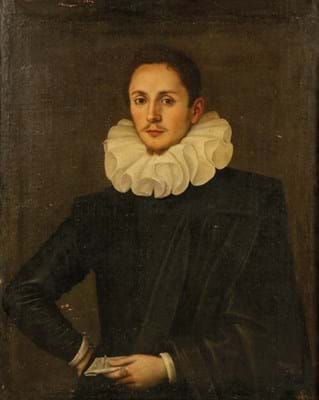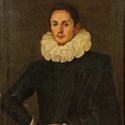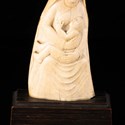The 6in (15cm) high piece was carved in c.1922 and depicts the Madonna and Child executed in the sculptor’s trademark ‘medieval’ style.
Less typical was his use of marine ivory: only three small pieces by Gill in this medium have been recorded, with the example at Duke’s not seen on the market for nearly a century.
Backed up by a reference in Gill’s ledgers, it is thought the piece had been commissioned by his friend, Father John O’Connor, a priest at St Cuthbert’s Church in Bradford.
It is also believed to be the same ivory Madonna and Child that was subsequently offered for sale in November 1922 at the Goupil Gallery Salon in London.
An old paper label to the base inscribed T W 4, Eric Gill Madonna and Child £100, seemingly points to this.
Sculpture resurfaces
Soon after, it disappeared from public view, entering the collection of the retail businessman Sir Ernest Debenham (1865-1952).
Unbeknown to Gill scholars, it remained with his family until it was consigned directly to Duke’s.
Debenham was a great admirer of Gill’s work and had commissioned the artist to create a memorial in the Dorset village of Briantspuddle to those of the local community who lost their lives in the First World War.
Estimated at £15,000-25,000 in the Dorchester sale on September 14, the ivory piece was initially left unsold as the saleroom failed to get through to two interested parties on the phones.
A private auction was conducted following the sale and it sold for £21,000 to a private collector.
Duke’s auctioneer Guy Schwinge said this was a “totally fresh discovery, its whereabouts had been unknown”. Sir Ernest was “a hugely important philanthropic figure in this part of the country”.
Russian sculptor
The section also yielded £42,000 from an overseas buyer for a bronze by leading Russian sculptor Prince Paul Troubetzkoy (1866-1938).
Estimated at £30,000-50,000, the 18in (46cm) high bronze of a woman seated in a chair had been consigned from an old European noble family, thought to have had connections with the sculptor.
Its composition is remarkably similar to Troubetzkoy’s better-known work After the Ball, a sculpture of the seated Milanese society hostess Adelaide Auernheimer (a version of which sold at Sotheby’s New York in April 2007 for a premium-inclusive $84,000/£42,200).
“The performance of these two pieces of modern sculpture underline the very strong market for sculpture and three-dimensional works of art within the fine arts sphere,” said Schwinge.
Beach bids
The biggest bidding war among the pictures was reserved for a 14 x 21in (36 x 54cm) post-war work of Brighton beach by Bloomsbury artist Duncan Grant (1885-1978).
Consigned from a deceased estate in Dorset, the 1949 oil on canvas is one of only a small group of Brighton views to have turned up at auction. Bidding was taken above the £5000-10,000 guide to £16,000, when it was hammered down to an anonymous buyer.
“Bearing in mind Brighton’s proximity to Charleston, it was an iconic image, but it wasn’t necessarily what Grant collectors traditionally like,” added Schwinge.
“The powerful still-lifes and naked men are most popular, but this was a very evocative image and clearly caused a lot of excitement.”
The Mod Brit section was not without some disappointment – notably Christopher Wood’s (1901-30) oil on canvas Shipping off Newlyn Harbour.
The c.1926-27 work had already been through the Dorset saleroom once – in July 2005 when it had taken £48,000 – but its reappearance a decade later appeared to dampen enthusiasm. It scraped away on bottom estimate to a private collector at £30,000.
Anvil hammered down
Elsewhere, a record was established for the recently deceased Irish artist Padraig Macmiadhachain (1929-2017).
Depicting Anvil Point on the Isle of Purbeck in Dorset, the artist’s home for much of his life, the 3ft (91cm) square oil on canvas is typical of the artist’s foray into simplified form and colour, executed through abstract landscape and seascapes.
The stylised work was snapped up by an interior designer at £5500, above the £3000-5000 guide. It betters the €5200 (around £4400) paid at Adam’s of Dublin in December 2010 for another harbour scene.
Further evidence of a general brightening in the middle market for traditional pictures (see last week’s ATG) was exemplified in the solid performance of a group of Old Masters from the same ‘European noble family’ that had consigned the Troubetzkoy sculpture.
Consisting of largely decorative 16th and 17th century Italian canvases, the group drew competition from the UK, US, Asia, New Zealand and Europe, the majority getting away in or above estimates.
Among the top-sellers was a striking portrait of a gentleman in a large ruff holding a letter, catalogued as ‘Circle of Giovanni Battista Moroni’ (1525-78).
The 3ft x 2ft 5in (91 x 74cm) oil on canvas, which had apparently retained in its original carved giltwood frame, sold to a private collector at £8000 against a £5000- 10,000 guide.





















